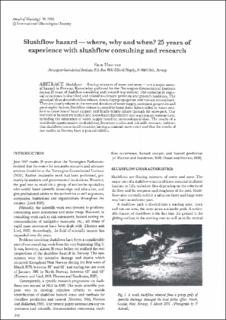| dc.contributor.author | Hestnes, Erik | |
| dc.date.accessioned | 2023-09-19T17:14:11Z | |
| dc.date.available | 2023-09-19T17:14:11Z | |
| dc.date.issued | 1998 | |
| dc.identifier.issn | 1727-5644 | |
| dc.identifier.uri | https://hdl.handle.net/11250/3090570 | |
| dc.description.abstract | Slushflows — flowing mixtures of water and snow — are a major natural hazard in Norway. Knowledge gathered by the Norwegian Geotechnical Institute during 25 years of slushflow consulting and research is presented. The variation in regional occurrence is described and related to climatic premises and ground conditions. The principal ideas about slushflow release, down-slope propagation and run-out are outlined. They are closely related to the rate and duration of water supply, snowpack properties and geomorphic factors. Slushflow release is caused by basal shear failure aided by water pressure to cause loss of basal support and finally tensile failure through the snowpack. Our methods of hazard evaluation and acute hazard prediction and warning are summarized, including the estimation of water supply based on meteorological data. The results of a worldwide questionnaire on slushflows, literature studies and scientific contacts, indicate that slushflows occur in all countries having a seasonal snow cover and that the results of our studies in Norway have a general validity. | en_US |
| dc.language.iso | eng | en_US |
| dc.publisher | Cambridge University Press | en_US |
| dc.subject | Slushflow | en_US |
| dc.subject | Hazard | en_US |
| dc.subject | History | en_US |
| dc.subject | Avalanche-RnD | en_US |
| dc.subject | Snøskred-FoU | en_US |
| dc.title | Slushflow hazard - where, why and when? 25 years of experience with slushflow consulting and research. | en_US |
| dc.type | Journal article | en_US |
| dc.rights.holder | International Glaciological Society | en_US |
| dc.source.pagenumber | 370-376 | en_US |
| dc.source.volume | 26 | en_US |
| dc.source.journal | Annals of Glaciology | en_US |
| dc.identifier.doi | 10.3189/1998AoG26-1-370-376 | |
